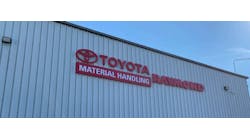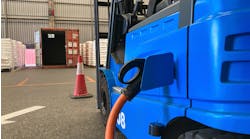It's no longer just industrial manufacturers benefiting from automation technologies. In the right situations, distribution centers (DCs) can be automated by laser-guided vehicles (LGVs), helping to increase both warehouse efficiency and safety while reducing costs.
LGV systems are usually implemented in existing warehouse environments, with little or no site modification required. Consequently, the investment is often reasonable with a relatively quick return on investment.
Depending on the storage method, the type of goods and the volumes shipped, the warehouse operator can opt for different types of LGVs, including counterbalanced or straddle vehicles capable of transporting one, two or more pallets at a time. The system can adapt to most methods depending on the type of goods, for instance, block stacking, drive-in racks, gravity racks, push-back racks and narrow aisle racking, giving the warehouse a high degree of flexibility.
A single pallet reach truck, for example, can answer the needs of a DC with very high racks. These types of reach trucks can handle goods at 36 feet high.
To perform work with extreme precision, the basic requirements for an LGV are small, passive reflectors located within the area to be automated. Everyday procedures, such as goods receiving, storing and shipping, can be automated this way. Daytime shipping can be facilitated by nighttime pre-staging, allowing prepared goods to be loaded into waiting trailers or containers as soon as the work day begins. Under certain conditions, LGVs can even handle the loading.
At any desired interval, and usually during the night, the LGVs can perform typical housekeeping tasks. For instance, they can concentrate pallets with the same kind of goods into full bins, leaving others empty, for time-saving handling during the day, and they can fill up the racks closest to the shipping area with the most frequently shipped products.
In addition to warehouse optimization, LGVs can help improve safety performance, thanks to technology that continuously scans the immediate surrounding area. If an obstacle is detected, the LGV slows down and eventually stops until the obstacle is removed, avoiding collisions.
The tasks performed during nighttime further reduce the required goods movement during the day, which makes the whole environment calmer and easier to manage. This efficient use of the system can also reduce the total number of LGVs needed.
Warehouse management system (WMS) software can be integrated with most existing computer systems and does not require the existing system to be exchanged. All pallets can be traced through the WMS at any point.
This information is based on material developed by Elettric 80, a provider of end-of-line automation solutions.


